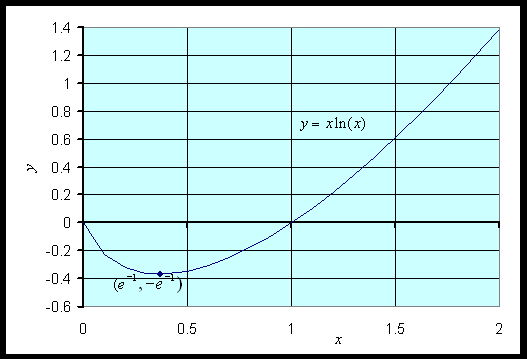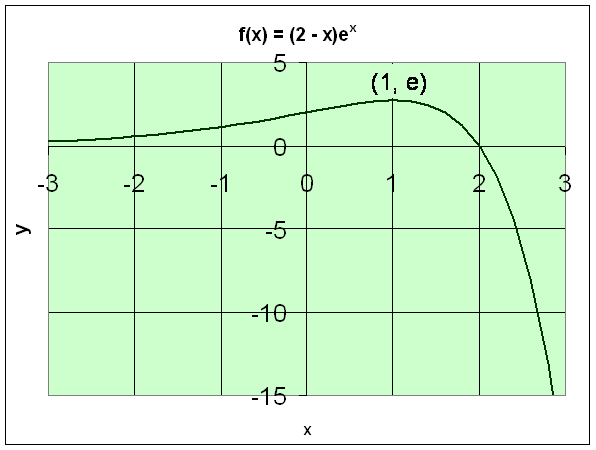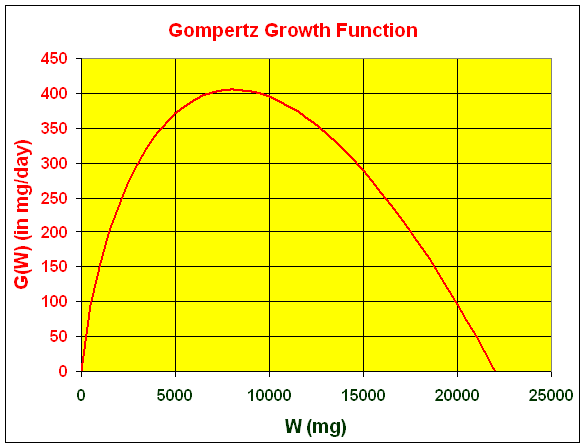Math 121 - Calculus for Biology I
Spring Semester, 2004
Product Rule - Examples
San Diego State University -- This page last updated 04-Jan-04
|
|
Math 121 - Calculus for Biology I |
|
|---|---|---|
|
|
San Diego State University -- This page last updated 04-Jan-04 |
|
When a function can only be written as the product of two or more differentiable functions, then the product rule is needed to find the derivative. Several examples are provided to supplement the lecture section and help with the homework problems. The examples include basic differentiation, a graphing example (finding a minimum), and additional studies of the Gompertz's model.
Differentiation of Functions with a Product
Example 1: Consider the function given by
Find the derivative of f(x) by using the product rule. Next multiply the terms in f(x), then take the derivative of the resulting polynomial. Show that these give the same functions, verifying the product rule.
Solution: The product rule is carried out by multiplying the first term times the derivative of the second term, plus the second term multiplied by the derivative of the first term.
We should be able to obtain the same result by multiplying the terms in f(x) and then taking the derivative of the resulting polynomial.
Thus, it is easy to see that the two methods do indeed yield the same result.
Example 2: Consider the function given by
Find the derivative of g(x) by using the product rule.
Solution: Again we multiply the first term times the derivative of the second term and add the second term multiplied times the derivative of the first term. Recall that the derivative of the natural logarithm equals the inverse of the argument.
One of the primary applications of the derivative is finding the critical points where minima and maxima occur, which aids in sketching a graph.
Example 3: Consider the function given by
Determine the domain of the function and find any intercepts. Find any critical points, then sketch the graph of f(x) for 0 < x < 2.
Solution: The domain of the function is x > 0. Thus, there is no y-intercept. However, it can be shown that the limit as x tends to 0 from the right is 0. (You can show this with your calculator, but proof of this result requires more advanced Calculus techniques.) The x-intercept is readily found by solving f(x) = 0, which gives x = 1.
To find the critical points we differentiate f(x) and set it equal to zero, giving
Thus, the critical value of xc satisfies ln(xc) = -1 or xc = e-1 ~ 0.3679. The function value at the critical point is f(e-1) = - e-1 ~ -0.3679. Thus, there is a minimum on the graph at (e-1, - e-1). The graph of the function is seen below.

Example 4: Consider the function given by
Find the x and y-intercepts and any asymptotes. Find any critical points, then state if it is a local maximum or minimum. Sketch the graph of f(x).
Solution:
Since f(0) = 2, the
y-intercept is (0, 2).
Since the exponential function is never zero, the x-intercept is easily seen to be (2,
0). In the limit as x tends
to ![]() ,
the exponential function goes to 0. An
exponential function dominates any polynomial function (as seen in the computer
lab earlier), so f(x) goes to 0,
which means that there is a horizontal asymptote to the left.
,
the exponential function goes to 0. An
exponential function dominates any polynomial function (as seen in the computer
lab earlier), so f(x) goes to 0,
which means that there is a horizontal asymptote to the left.
The critical points are found by differentiating f(x) and setting it equal to zero, so
It is easy to see that the critical value of xc is xc = 1. The function value at the critical point is f(1) = e1 ~ 2.718. Thus, there is a maximum on the graph at (1, e). The graph of the function is seen below.

Example 4: Suppose the the growth of a tumor is given by the Gompertz growth function
where W is the weight of the tumor in mg and the time units are days. Find the equilibrium weight of the tumor. Find the maximum growth rate for this tumor, then sketch the graph of G(W).
Solution: The equilibrium is found by solving G(W) equal to zero, so
G(W) = W (0.5 - 0.05 ln(W)) = 0
0.5 - 0.05 ln(W) = 0
ln(W) = 10
W = e10 = 22,026 mg.
To find the maximum growth, we differentiate G(W), so
G '(W) = W (- 0.05 (1/W) + (0.5 - 0.05 ln(W))
= 0.45 - 0.05 ln(W) = 0.
Thus,
ln(W) = 9
W = e9 = 8,103 mg.
with a maximum growth rate of
G(8,103) = 8,103(0.5 - 0.05 ln(8,103)) = 405.2 mg/day.
Below is a graph of this function
